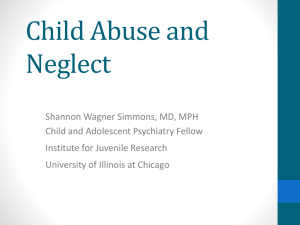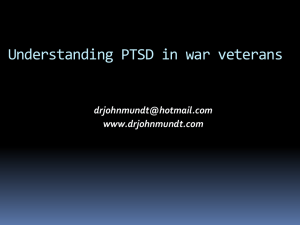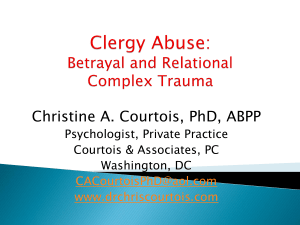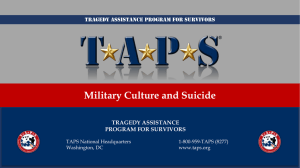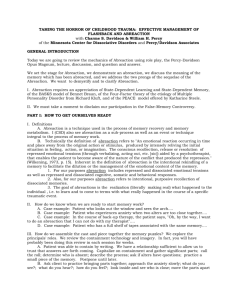CHALLENGES TO TREATMENT - Mental Health America of Wisconsin
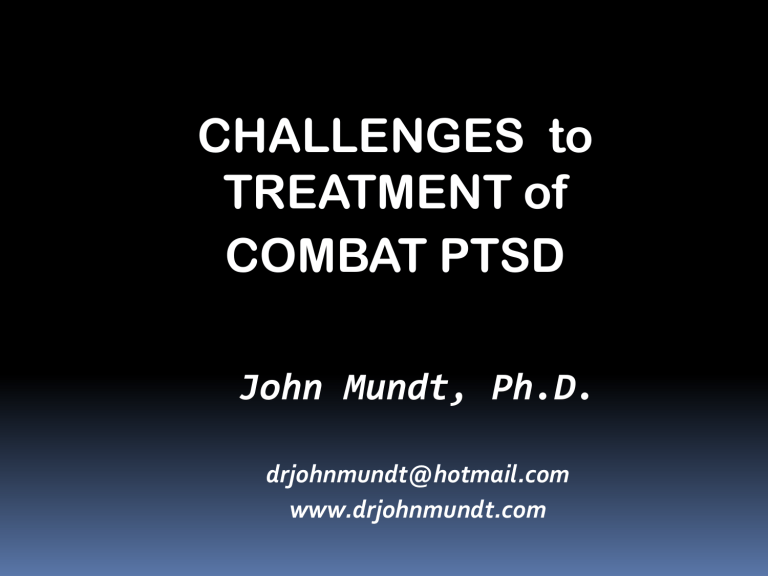
CHALLENGES to
TREATMENT of
COMBAT PTSD
John Mundt, Ph.D.
drjohnmundt@hotmail.com
www.drjohnmundt.com
CHALLENGES TO TREATMENT
Cultural / subcultural considerations
MILITARY CULTURE
Importance of group over individual
“What happens in the bush, stays in the bush”
“Machismo”
Issues re: authority
GENERATIONAL
Young adults
vs reservists
ETHNICITY/NATIONAL ORIGIN
Culturally appropriate emotional expression
CHALLENGES TO TREATMENT
Other Mental Health Problems
Pre-existing Trauma
Common Therapist Error: failure to assess for other trauma
Can be from many non-military sources: childhood abuse, traumatic loss, correctional system, addiction
Discrete trauma (rape, natural disaster) vs. prolonged or repeated
Multi-layered trauma: complex, more difficult to treat
CHALLENGES TO TREATMENT
Other Mental Health Problems
“Personality Disorders”: Problem of diagnosis and nomenclature
Controversial use of Character Disorder diagnoses by military
“Cluster B” personality traits: overlap with concept of multiple layers of trauma
Continuum of trauma-based disorders: PTSD, BPD, DID are all possible responses to stress and trauma
“Personality Disorder” can both increase and decrease likelihood of “PTSD”
CHALLENGES TO TREATMENT
Other Mental Health Problems
Other Axis I psychiatric illness
Typical onset age for chronic mental illness coincides with military service
Diathesis-Stress Model: warzone deployment is the stress
Risk of assuming PTSD in all OEF/OIF veterans presenting for treatment
Assess family history of mental illness/psychiatric treatment
TRAUMATIC BRAIN INJURY (TBI)
TRAUMATIC BRAIN INJURY (TBI)
“Signature Injury” of this war
• Explosions account for 3 of 4 combat-related injuries 1
• Use of IED’s in Afghanistan and Iraq
• Improvements in warzone trauma treatment decrease fatalities
• Exposure to toxins, other causes of brain injury
1 Zouris,J.M., Walker, G.J., Dye, J. & Galarnewau, M. (2006). Wounding patterns for U.S. Marines and sailors during Operation Iraqi Freedom, major combat phase. Military Medicine, 171(3):246-52.
CHALLENGES TO TREATMENT
ADDICTION and SUBSTANCE ABUSE
Alcohol, cocaine and methamphetamine were available in Iraq
Afghanistan is world’s largest producer of opium
Many medically injured troops are prescribed painkillers
VA: 10%+ increase in veterans seeking drug treatment since start of war
Significant impediment to treatment of OEF/OIF veterans with PTSD
Lessons from Vietnam veterans
ADDICTION and SUBSTANCE ABUSE
Factors leading to substance abuse problems:
Pre-existing problems
“Self-medication” of depression, PTSD
Chronic pain
Boredom
Affiliation/ peer pressure: culture
Pre-existing substance use/abuse
“Self-medication”
Anxiety and hypervigilance
Insomnia
Depression
Anger and volatility
CHRONIC PAIN
Intractable pain as a chronic stressor
Physical demands of military deployment: “Battle rattle”
Headaches: PTSD versus TBI versus other medical basis
Orthopedic, neurological, psychosomatic
Medication of “pain”: physical versus emotional
Boredom/ isolation/ avoidance
Culture of drinking
CHALLENGES TO TREATMENT
ADDICTION and SUBSTANCE ABUSE
DAY HOSPITAL PROGRAM approach:
Detailed assessment
Psychoeducation: - use vs. abuse vs. dependence
-abuse = impairments in functioning
(emotional, vocational, social, physical)
Emphasis on honesty over total abstinence
Lapses are a part of recovery: lapses are not relapses, but may lead to them
Continued abuse: progressive “tightening of the reins”
(Dual Diagnosis engagement groups for combat veterans)
Caveats: dangerous use, clear-cut dependence, historical treatment failures
CHALLENGES TO TREATMENT
ADDICTION and SUBSTANCE ABUSE
Dangers of extremes in therapist stance:
TOO PERMISSIVE:
Failure to benefit from treatment
Intoxication, self-medicating as end-point of abreaction
Therapist frustration
TOO RIGID:
Withdrawal from treatment
Contraindications of formal addictions programs
CHALLENGES TO TREATMENT : SUICIDE
Lessons from Vietnam
CHALLENGES TO TREATMENT : SUICIDE
Literature: Both trauma exposure and specific diagnosis of PTSD are linked with suicidal behavior.
Why?
Despair
Impulsivity
Guilt / Grief
“Misadventure”
CHALLENGES TO TREATMENT : SUICIDE
High-profile suicides of OEF/OIF veterans have led to changes in VA policy/approach:
• Suicide hotline
(National Suicide Prevention
Lifeline: Call
1-800-273-TALK (8255), and press “1” to be connected to
VA hotline)
• Suicide Prevention Coordinators
• Increased outreach and follow-up
CHALLENGES TO TREATMENT :
SUICIDE
ASSESSING RISK: Patterson et al’s “SAD PERSONS” mnenomic:
S ex (male)
A ge (elderly or adolescent)
D epression
P revious suicide attempts (highest risk within 3 months of prior attempt)
E thanol abuse (alcoholics’ rate of suicide is 50x that of non-alcoholics)
R ational thinking loss (psychosis)
S ocial supports lacking (subjective perception of lack)
O rganized plan to commit suicide (specific, lethal)
N o spouse (divorced > widowed > single)
S ickness (physical illness)
Patterson WM, Dohn HH, Bird J, et al. Evaluation of suicidal patients: the
SAD PERSONS scale. Psychosomatics 1983;24(4):343-9
CHALLENGES TO TREATMENT :
SUICIDE
ASSESSING RISK: Suicide warning signs in veterans o o o o o o o o
CHANGE in behavior
Calling friends, particularly vets, to say goodbye
Cleaning weapons
Visiting graveyards
Stopping or hoarding medication, alcohol
Spending sprees, buying gifts
Obsession with media coverage of war
Wearing uniform, combat gear
CHALLENGES TO TREATMENT :
SUICIDE
WEAPONS and OEF/OIF veterans
“Don’t leave home without it!”
CHALLENGES TO TREATMENT :
SUICIDE
GENERAL CONSIDERATIONS with OEF/OIF veterans
Efficacy of no-suicide contracts
Importance of ongoing assessment during trauma therapy
Crisis Intervention: plan ahead
CHALLENGES TO TREATMENT :
VIOLENCE
ASSESSMENT: Should be specific
Impulsive/reactive (in context of hyperarousal?
Dissociation?) AFFECTIVE VIOLENCE
Planned/deliberate (starting fights? “patrolling”?) PREDATORY VIOLENCE
Domestic violence
Intoxication (disinhibition?)
Related to peer-group
“Suicide by cop”
CHALLENGES TO TREATMENT :
VIOLENCE
WEAPONS
PARANOIA STIMULANTS
Common “points of contact” for vets with legal system:
Substance abuse (DUI/DWI; intoxication)
Aggression and violence (DV; workplace; public fights)
Suicidal behavior
Driving offenses
Weapons
“disorderly”: crowds, authorities
CHALLENGES TO TREATMENT
HOSPITALIZATION
Should be brief if possible
Initial experience may determine future compliance in emergency situations
Acute versus planned (specific programs)
CHALLENGES TO TREATMENT
Confronting AMBIVALENCE
TRAUMA is about loss of power and control
Psychoeducation should be ongoing: joint perusal of a roadmap
Flexibility in “closing cases”: “diminishing orbits” concept
CHALLENGES TO TREATMENT
MALINGERING
Politics of PTSD and disability benefits:
"We have young men and women coming back from Iraq who are having PTSD and getting the message that this is a disorder they can't be treated for, and they will have to be on disability for the rest of their lives. My concern about the policies is that they create perverse incentives to stay ill. It is very tough to get better when you are trying to demonstrate how ill you are.“
Process of assessment should include questions re: claims, benefits
Detecting/confronting malingering is at odds with usual therapist stance
CHALLENGES TO TREATMENT
DETECTION of MALINGERING
Assess for secondary gain (VA claims, lawsuits)
Psychometric measures (both specific to PTSD, and general like MMPI-2)
Presentation of client: “every symptom in the book”
Traumatic material: no distress upon exploration OR total avoidance
Traumatic material: inconsistent with probable experience
Benefit of therapy groups
COMMON THERAPIST ERRORS
1) Premature focus on trauma processing
2) Avoidance of trauma processing
3) Projection of therapist’s beliefs and values about military experience
4) Projection of therapist’s assumptions about what is and what is not traumatic
5) Inadequate assessment of trauma history
COMMON THERAPIST ERRORS
1) Premature focus on trauma processing: “Get it all out”
Can lead to:
• Frightening dissociation
• Suicidal or violent behavior
• Withdrawal from treatment
• Abreaction
ABREACTION: Intense reliving of the trauma
• Freud (1892) used hypnosis to facilitate
• Long considered an important part of trauma therapy
• Technique or adverse effect?
copyright Mundt 2012
ABREACTION as a goal of therapy:
• “Lancing a boil”
• Bennett Braun’s BASK theory:
• Dissociative client needs to re-experience b ehavior, a ffect, s ensation, k nowledge
• (Braun, B.G. (1988) BASK Model of
Dissociation, Part I. Dissociation, 1:1, 4-23)
ABREACTION as an adverse effect:
• Painful and intense: somatic memories
• Dangerous behavior during dissociation
• Persists beyond session
ABREACTION:
“The abreaction of intense affect is not a goal of psychotherapy; it is an inevitable concomitant experience in the therapy of persons with post-traumatic histories, physical and/or sexual abuse, neglect, and related innate experiences.”
Chefetz, R.A. Abreaction: Baby or Bathwater. Dissociation
Vol.X, No.4, 12/97
Managing ABREACTION:
•
•
•
•
Maintain a calm demeanor
Consider your tolerance for extremity and for strong affect
Safety considerations
Consider both timing and pacing of sessions
COMMON THERAPIST ERRORS
2) Avoidance of trauma processing can lead to:
• Worsening of symptoms and related behavior
• Increased subjective pressure to “self-medicate”
• Entrenching maladaptive coping responses
• Withdrawal from treatment
COMMON THERAPIST ERRORS
3) Projection of therapist’s beliefs and values about military experience
• Do a “self-assessment” as to your own views of the war, your assumptions about the military, about soldiers
• Consider the source of your beliefs and assumptions
COMMON THERAPIST ERRORS
4) Projection of therapist’s assumptions about what is and what is not traumatic
• Importance of assessment not just of experiences, but of client’s PERCEPTION of those experiences
• Avoid “loaded” words like traumatic : Ask “what was hardest for you?”
• Maintain awareness of triggers/stressors unique to
OEF/OIF experience (i.e., Arab-appearing clinicians/staff)
• Be alert for vicarious traumatization
(“PTSD by proxy”)
COMMON THERAPIST ERRORS
5) Failure to assess for “layers” of trauma
• Assessment should include childhood and other noncombat trauma
• Consider possible causes of failure to disclose
(subjectively “unsafe”, security clearances, classified
“black ops”)
10 things to do in
Session #1 !
#1: PRAISE the client
#2: VALIDATE their experience
#3: EDUCATE about pacing and timing
#4: PREDICT the course of treatment
#5: ACCEPT the inappropriate
#6: EXPLAIN parameters of sessions
#7: WARN about worsening of symptoms
#8: EMPLOY analogies liberally
#9: OFFER human touch
#10: GIVE something to read
10 things to do in
Session #1 !
#1: PRAISE the client
-
Reinforce their decision to start this process
-Acknowledge the difficulty in this, the stigma, the risk
-Express optimism
10 things to do in Session #1 !
#2: VALIDATE their Experience
-Normalize post-Traumatic reactions
-De-pathologize PTSD symptoms
10 things to do in Session #1 !
#3: EDUCATE about timing & Pacing
-Ask about previous experience of flooding
-Want to avoid “Overdosing”
10 things to do in Session #1 !
#4: PREDICT the course of therapy
-Educate about your model
-Estimate length/duration
10 things to do in Session #1 !
#5: ACCEPT the inappropriate
-”Gallows” humor
-Extreme views, statements
-Prejudices, profanity
10 things to do in Session #1 !
#6: Explain parameters
-”housekeeping”
-Crisis procedures, availability
10 things to do in Session #1 !
#7: Warn about worsening symptoms
-important caveat
-”Stirring the mud in the
puddle”
10 things to do in Session #1 !
#8: Employ analogies liberally!
-Process of turning an 18-wheeler around
-Hurricane reporters
-veterans: basic training drills
-bowel/bladder analogies
10 things to do in Session #1 !
#9: Offer human touch
-only if indicated
-can be grounding or alarming
10 things to do in Session #1 !
#10: Give something to read
-pamphlets
-reading list
-websites
drjohnmundt@hotmail.com
www.drjohnmundt.com

